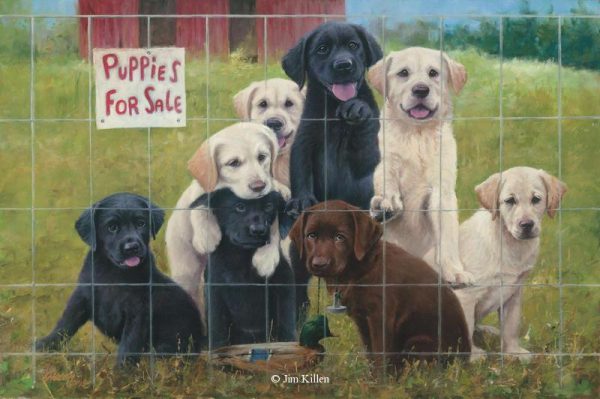
We’ve all heard someone say it at least once in our lifetime: They’ll refer to a Lab as a “Golden Labrador Retriever, and “inwardly, those of us who know better we cringe. There are only three acceptable colors for Labrador Retrievers, and none of them are “golden.” Not anymore, anyway.
In the earliest days of the breed until the mid 1900s, the dogs we now call “yellow” Labrador Retrievers were called “golden,” in large part because they were a dark, almost butterscotch shade of yellow. England’s Kennel Club changed the term because it said that “gold” wasn’t an actual color. Since lighter shades of yellow were becoming preferred anyway, it became a moot point.
Veterans of NPDD know how we give ourselves brain freeze by trying to understand genetics at a deep level, but we have been able to grasp from our reading that there are nine possible combinations of genes that will determine a Lab’s color, and of those nine, one combination should be avoided: Yellow Labs carrying two recessive genes for the chocolate color will produce yellow pups, but with chocolate pigmentation in their eyes rims and nose. Breed two yellow Lab together, and you’ll get yellow puppies. They’ll never throw brown or black puppies. This is because yellow dogs don’t have the so called “big E gene”needed to switch off the masking effect.
Ultimately, working out the colors that Lab puppies will be is tough without knowing the parent’s genotype (the genes that determine characteristics).
When scouting for puppies, potential Labrador Retriever owners should be very wary of the breeder who claims that a puppy’s color is “rare” color for the breed. Remember, there are only three acceptable colors in the AKC, and they’re not silver, they’re not gold, they’re not gray, they’re not brindle, they’re not goldador and they’re not black and tan. They’re either yellow, black or chocolate.
A word about “goldador.” It’s not a color, it’s a mix that’s the result of a Golden Retriever and Labrador Retriever bred together. Don’t be fooled into thinking that two fabulous breeds in their own right can be made better by breeding them. Unethical breeders may tout that you get the best of each breed with such a blend (are they geneticists?) but you may also get the worst.
Old timers used to say that it’s best to avoid riding one two horse with one ass. Pick the best fit of breed for your life and don’t be an ass. Just saying.
“Puppies for Sale” by Jim Killen
http://www.killenoriginals.com
jim@killenoriginals.com

I have owned both a Golden Retriever and a Yellow Lab. I can attest that the Golden really deserves the name. She was always beautiful, but in full sun her coat caught the light and spun it back as though lit from inside.
The Lab was a fine girl, too, but her coat never displayed that shining quality.
My Golden Lab is certainly not yellow. Her coat is golden in colour.
My Golden Lab is certainly not yellow. Her coat is golden in colour.
Would love to see a picture, Margaret!
Sorry, no matter what color your yellow lab is, from fox red to cream, the name is still yellow. it is fingernails on a chalkboard for me to hear Golden lab. No such thing. See my yellow (often referred to by some as white) lab.
White Lab is equally nails on chalk board!!!
My Yellow girl… Not white or Golden!!!!!!!!
CCI’s breeding program mixes Labs and Goldens for their assistance dogs. The dogs are all neutered – they never breed the second generation. They call those “Golden Labs”.
names like this are a detriment to both breeds – Look at the statement by the guy that 1st coined the term “labradoodle.” He is VERY sorry he ever did this.
I would request that CCI use the term Golden/Labrador Mix or Goldador if they need a cutsey name. “Golden Lab” may mean Golden-Lab mix to them, but it is confusing to the general public, and creates more work to educate the public by breeders striving to preserve BOTH breeds.